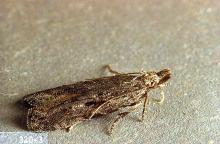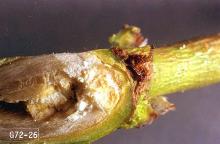Anarsia lineatella
Pest description and crop damage The peach twig borer is a European insect first found in California in the 1880s. It is a major pest of apricots, peaches, plums, and prunes. There are no known hosts outside the orchard. The adult is a gray moth with white and dark scales, about 0.33 to 0.5 inch in length. When mature, the larva (caterpillar) is about 0.5 inch in length, with a dark brown head and distinctive, alternating light and dark bands on the body. Larvae injure fruit trees by feeding on the buds and twigs early in the season, then the larvae bore into the shoots, causing a characteristic "flagging" or wilting of the new growth. Later generations of larvae feed within shoots or even on the fruit itself. Flagging of twigs indicates an infestation.
Biology and life history The peach twig borer overwinters as an immature larva in tunnels constructed within the crotches of twigs and branches. These overwintering sites can be identified by the small chimneys of frass (excrement) and wood chips produced by the feeding of the larvae. Larvae are active at the pink bud stage and feed on buds and young leaves before boring into a shoot. These larvae eventually leave the mined shoot to pupate. Adults then emerge in mid- to late May. Eggs are laid on fruit, shoots, or undersides of leaves. Eggs are yellowish white to orange. Larvae feed and mature on shoots and immature fruit. The next adult flight is in mid-July. Some of the larvae from this flight overwinter, the rest produce a partial third flight.
Pest monitoring Early in the spring, scout fruit trees for the new growth for flagging shoots that foreshadow a need to protect the fruit later in the season. Peach twig borer moths can be monitored with pheromone traps placed in the orchard by early May.
Management-chemical control
Early sprays aimed at the newly hatched larvae before they bore into the shoot, or fruit, will provide the best control of peach twig borer.
Management-chemical control: HOME USE
Warning: Many pesticides are hazardous to bees. Look for bee precautionary statements on product labels and do not use these products during bloom or if bees are foraging in the orchard.
- acetamiprid-Toxic to bees.
- azadirachtin (neem extract)-Some formulations are OMRI-listed for organic use.
- carbaryl-Highly toxic to bees.
- esfenvalerate-Highly toxic to bees.
- gamma-cyhalothrin-Highly toxic to bees.
- kaolin clay-Repels some insect pests when applied as a spray to leaves, stems, and fruit. OMRI-listed for organic use.
- lambda-cyhalothrin-Highly toxic to bees.
- pyrethrins-Toxic to bees. Some formulations are OMRI-listed for organic use.
- spinosad-Highly toxic to bees. Some formulations are OMRI-listed for organic use.
- zeta-cypermethrin-Highly toxic to bees.
Management-chemical control: COMMERCIAL USE
Delayed-dormant and prebloom sprays
Warning: These products are toxic to bees. Do not use them during bloom or if bees are foraging in the orchard.
- chlorantraniliprole (Altacor 35 WDG) at 3 to 4.5 oz/A. REI 4 hr.
- flubendiamide /buprofezin (Tourismo) at 10 to 14 fl oz /A. REI 12 hr.
- phosmet (Imidan 70-W) at 4.25 lb/A. REI 7 days. Extremely toxic to fish; avoid spray drift and runoff to surface waters.
- spinetoram (Delegate WG) at 3 to 7 oz/A. REI 4 hr.
- spinosad (Entrust 80W) at 1.25 to 2.5 oz/A. REI 4 hr. Results are best when applied at petal fall. OMRI-listed for organic use. May act slowly.
Spring application
- Isomate OFM/PTB TT at 100 to 200 dispensers/A. Dispensers must be in the orchard before adults begin flying in spring. Place dispensers in the upper one-third of the tree or higher. Some formulations are OMRI-listed for organic use.
Spring and summer sprays
- Bacillus thuringiensis var. kurstaki-Check labels for rates. REI 4 hr. PHI 0 days. These products work best when temperatures exceed 50°F over 3 consecutive days. Some formulations may be OMRI-listed as organic.
- chlorantraniliprole (Altacor 35 WDG) at 3 to 4.5 oz/A. REI 4 hr. PHI 10 days.
- flubendiamide + buprofezin (Tourismo) at 10 to 14 fl oz /A. REI 12 hr. PHI 14 days.
- methoxyfenozide (Intrepid 2F) at 8 to 16 fl oz/A. REI 4 hr. PHI 7 days.
- phosmet (Imidan 70-W) at 1.25 to 4.25 lb/A. REI 7 days. PHI 14 days. Not to exceed 4.25 lb/A or 3 lb ai/A per season. Extremely toxic to fish; avoid spray drift and runoff to surface waters.
- spinetoram (Delegate WG) at 3 to 7 oz/A. REI 4 hr. PHI 1 day.
- spinosad (Entrust 80W) at 1.25 to 2.5 oz/A. REI 4 hr. PHI 1 day. Results are best when applied at petal fall. OMRI-listed for organic use. May act slowly.




